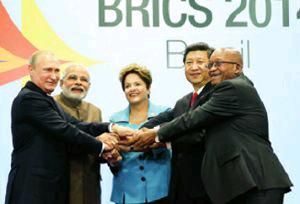A New Pole of Global Finance
2014-08-27ByBaiShi
By+Bai+Shi
Brazil continues capturing the worlds attention even as the 2014 FIFA World Cup soccer tournament has come to an end in the country. The Sixth Summit of BRICS countries—Brazil, Russia, India, China and South Africa—was held in the northeastern city of Fortaleza on July 15 under the theme of Inclusive Growth: Sustainable Solutions.
The meeting was attended by Brazilian President Dilma Rousseff, Russian President Vladimir Putin, Indian Prime Minister Narendra Modi, Chinese President Xi Jinping and South African President Jacob Zuma. They discussed solutions to development challenges and showcased their cooperative accomplishments.
The Fortaleza Summit commences the second round of the annual BRICS summit, which the five countries take turns hosting. The first BRIC summit—South Africa was not included in the bloc until 2010—was held in the Russian city Yekaterinburg in 2009, initiating the cooperation mechanism of the emerging economies.
In the past five years, BRICS has forged an impressive partnership and extended common interests in the midst of a complex international context. At present, the emerging-economy bloc has been implementing cooperation initiatives in more than 30 fields.
Undoubtedly, the establishment of the New Development Bank (NDB) and the Contingent Reserve Arrangement (CRA) tops the agenda of this years summit. It is a long-awaited achievement signaling a big step forward in the groups role in global financial governance.
According to the Fortaleza Declaration, the NDB, to be headquartered in Chinas Shanghai, aims to finance infrastructure and sustainable development projects in BRICS and other emerging and developing economies. It shall have an initial authorized capital of $100 billion. The initial subscribed capital will total $50 billion, equally shared among founding members. The NDB will also set up an African regional center in South Africa, which will be established concurrently with the headquarters.
And the CRA—with an initial size of $100 billion—will help countries forestall short-term liquidity pressures, promote further BRICS cooperation, strengthen the global financial safety net and complement existing international arrangements. Both the NDB and CRA are open to other developing countries. Each member provides a different amount of capital in the CRA according to their financial situation. China offers the largest capital sum of $41 billion to the reserve and receives a credit of $20.5 bil-lion. South Africa provides $5 billion and has a doubled credit of $10 billion.
An alternative way?
Since BRICS made its announcement, the new finance institution has been subject to widespread global attention. Western media outlets have asked whether it will act as an alternative to the current Bretton Woods institutions, including the International Monetary Fund (IMF) and World Bank.
“The new bank is established for the purpose of promoting development of BRICS countries, especially in terms of infrastructure development in these countries. It is to meet the demand of BRICS and is also a beneficial supplement of current international institutions rather than a competitor,” Huang Wei, a researcher with the Institute of World Economics and Politics under the Chinese Academy of Social Sciences (CASS), told Xinhua News Agency.
BRICS countries have been exploring ways to strengthen their cooperation in global finance governance since 2009. At their fourth summit in New Delhi in 2012, BRICS members agreed in principle to set up a South-South development bank that will be funded and managed by BRICS and other developing countries. In the past two years, BRICS finance ministers and central bank governors undertook the work of coordinating and structuring the framework for the new bank.
Along with the rapid economic growth, current international financial institutions are unable to meet the demands of emerging countries. The World Bank, for example, aims to help undeveloped countries reduce poverty. But BRICS countries cannot acquire loans from the World Bank because of their growing percapita income, Huang said.
Additionally, infrastructure investment is highly demanded in emerging countries. But commercial lending agencies prefer shortterm projects to infrastructure investment that entails long-term commitment and high risks. The NDB is expected to help meet the financing gap of infrastructure in developing countries, according to Huang.
“China has much experience and sufficient capacity in infrastructure construction. The NDB will offer opportunities for Chinese enterprises to cooperate with other members of BRICS in the field,” Huang said. “Moreover, infrastructure construction will facilitate communication and trade between each other and create job opportunities in emerging countries. It is an effective way to realize inclusive growth.”
World Bank President Jim Yong Kim also welcomed the birth of the NDB during his visit to China on July 8, Hong Kong-based South China Morning Post reported.
